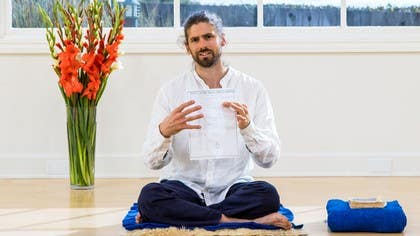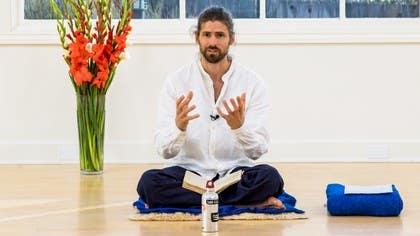Description
See below .PDF on the Tattvas that James discusses in this talk.
About This Video
Transcript
Read Full Transcript
So, having told us that he's going to tell us about yoga, Patanjali continues in the second sutra, yoga ha chitta vritti nirodha ha, then in the third, tada drashtuhu svarupayavastanam. So yoga chitta vritti nirodha, we can see here the concision of the sutra form. The verb isn't stated. The verb is just understood, the verb to be. So yoga is the nirodha of the chitta vritti.
So chitta vritti, it becomes a compound word, but it means the vritti of the chitta. And yoga is the nirodha state of the chitta vritti. So what do these words mean? So here Patanjali is defining yoga as the nirodha of the chitta vritti. So nirodha basically means checking.
Sometimes you'll see translations refer to this as stopping. But nirodha, I think it's quite helpful to think of it as checking. If you want to check something, first you have to acknowledge it. You have to look closely to check. Vritti, vritt means that which is rotating or moving.
So the root which gives us vritti also gives us the verb which gets conjugated in the present tense as vartati. So if, for example, you have a friend called, let's say he's called Tom. And Tom lives in the city of York. York's a city in England, for example. So you could say Tom lives in the city of York.
We would say in Sanskrit, Tom, York nagari vartati. This means Tom lives in the city of York. In other words, he vritti in York. He vritti in the city of York. So vritti, it means that which is moving.
But vritti is also the verb that gets used in Sanskrit for when you live somewhere. So vritti, it's that which is rotating. And this is very important because yoga recognizes that life is basically pulsation. It's expansion and contraction. It's a breath cycle.
It's a heartbeat. All of life is pulsation, dynamism, movement. Now when you think of a pulsation as an expansion and a contraction, you can also think of this as a cycle. It's going up. It's expanding.
It's going down. It's diminishing. And again and again. So yoga recognizes that this is the essence of life. Its movement is expansion, contraction, its cycles.
So life, vritti, it's doing this. It's going around. It's turning. It's pulsating. What then is chitta?
Chitta basically means embodied consciousness. Chitta refers to all of those powers through which we experience. So sometimes people translate this sutra with something like yoga is the stopping of thoughts. Or yoga is when the fluctuations and vacillations of the thought cease. Now such a translation is not wrong, but I don't think it's complete.
Certainly it's helpful. Does the idea that if we can stop thinking too much, we are less likely to be enslaved or tyrannized by limiting beliefs or limiting ideas that we might think about ourselves? Because one of the key ideas in yoga is to actually go beyond the limits of the limiting ideas we have about ourselves to recognize who we really are and what we're really made of. But if all the movements of the field of our awareness stop, we're no longer alive because life is movement. So the way I consider this sutra is rather than saying it's stopping thought, chitta is much more than thought.
Chitta, as far as I understand it, can really be said to refer to all of the constituent powers through which we have conscious experience. Chitta means that which is conscious or is consciousness. So chitta is embodied consciousness. So in the yoga system, yoga is a school of Indian philosophy. And any school of Indian philosophy exists, we might say, at least at some level in relation to a system called sankya.
Sankya is generally considered to be the oldest school of Indian philosophy. And sankya is related to the verb which means to enumerate or to count. And sankya gives us a model of the universe in which there are these things called tatvas. Now tat means that, that which exists. Tva means having the quality of.
So tatva is that-ness, something that is, something that exists. And the idea in sankya is that as an individual conscious being, that which we are is constituted of different parts. And the yoga system uses the same basic model. So in some instances, in some tantric schools, this gets expanded, so rather than there being the 24 tatvas that we are about to see, or the 25 tatvas that we are about to see in sankya yoga, in some tantric schools there will be 34 or 36 tatvas. So what are these tatvas?
These tatvas are a way of describing this realm of chitta. So there is this sheet that we can refer to. And on this sheet we'll see the 25 tatvas of sankya yoga. Now in sankya, and in yoga, there are two basic tatvas, purusha, which means consciousness, and the language of Patanjali, the seer, that which sees, that which allows us to experience, and prakrti, that which is experienced or seen, in other words, manifest nature. So purusha, the underlying enabling animating conscious essence, and prakrti, this phenomenological world that we experience of nature.
But how do we experience it? Of course, we have to have this underlying consciousness that's enabling us to have any experience at all. But when we experience, we experience it through these tatvas. And so we're going to work from gross to subtle, from the bottom back up, there's the idea that we're constituted at a certain level of the elements, earth, water, fire, air, and space. And these elements correspond to the senses.
So for example, earth corresponds to fragrance, water to taste, fire to form things that can be seen, air to things that can be felt, and sound to things that we can hear. So this gives us the five elements, kritivijala, agni, vayuna, karsha, and the five tanmatras of ganda, fragrance, rasa, taste, rupa, form, sparsa, touch, and shabda, sound. And then we have what are called the indriyaha. And the indriyaha are the divine powers of our body and our senses, sometimes referred to in the Indian system as devata, again, which means divine power. So this is a very beautiful and practical idea.
There's the idea that when you're a human being, you are endowed with divine powers. So if you think about it, divine in the sense that they allow us to see, they have light, they have luminosity, they allow us to have a conscious experience. So when we're embodied, we have these five karmindriyaha, these five powers of doing. And we see them here, vak, to speak, to articulate, paani, relating to our hands, to pick things up, put things down, pada, to move, to locomote, paayu, excretion, unupasta, procreation. Now when we see these five, we can think, okay, yes, talking, picking things up, putting things down, moving around, excreting waste, and procreating.
Okay, makes sense. But there is more to this than might first meet the eye. Because vak does not just mean our capacity to make a sound, vak also relates that bigger capacity to express. Similarly, paani, picking things up and putting things down, this doesn't just relate to the physical capacity to pick something up and put things down. This also relates to our capacity to pick up ideas and let them go, for example.
Pada, locomotion, we can move not just in physical space, we can also move in terms of how we feel, how we orient, how we perceive things. And then these last two, paayu and unupasta, it doesn't just mean going to the toilet and making babies, paayu is this capacity we have as human beings to leave behind things that no longer serve us, to free ourselves of that which might be a burden if we keep on carrying it. And then upasta, as well as the capacity to reproduce, this is the recreational capacity, which is a very, very wonderful thing with which we are blessed as human beings. Now this word, recreation or recreation, in some latin languages like French, Italian, Spanish, the most important period in the school day is called this, la recreation, el recreo, la recreation, it's the break time at school, the play time. This is when the most learning happens.
I used to be a school teacher, play is so important because when we play, we recreate our understanding of what is our limit. The idea, when you see kids playing, like where I spend time, where my father lives, I walk past the school when I go into town to get the groceries or something like that. And when you see the kids playing, you see that there's always this searching, this exploration, this exuberance. And when you do that, when you make movements you never made before, when you do things you never done before, what happens to our understanding of ourselves? It gets recreated, it gets reshaped in a perhaps broader, vaster, more inclusive form.
And so this power, or these two powers of pa-yun-u-pasta are very, very important for the practice of yoga. Because yoga is about recognizing, okay, I've got these limiting ideas, but maybe there is an opportunity to do something about them. And that is through practice we can recreate our understanding of ourselves and expand it to be one that's more inclusive. So these are the karmindriyaha, the powers of action. Not just the part of ourself, the power that allows us to do something, but the intrinsic power that allows the way we do things to give us an experience that is more conducive to yoga or wholeness or satisfaction or fulfillment, or more likely to enmesh us in limiting ideas.
Then we have the jnanindriyaha. And these are the indriyaha, the divine powers of jnana, of knowing. And these relate to the five powers of our senses. And then we have these three, which are deliberately not translated here on the sheet, manas, ahankara and buddhi. And collectively these three are referred to as the antakarana, which means the internal instrument, the internal instrument of our awareness.
Manas often gets translated as mind, and it's that part of our interior mental apparatus that links the powers of the indriyaha to that central awareness. Then ahankara, aham, means I, kara means maker, so ahankara literally means the I maker. It's that part of our awareness that connects our experiences or processes our experience in such a way that they connect to our sense of individuality or identity. So for example, if you're leaving a room and you look back and you see your bag, oh that's my bag, your manas connects the sense power of the organ of sight to your internal processing apparatus and then ahankara helps you, oh that's mine. So ahankara is that part of the awareness that gives us this sense of I, me and mine.
And then buddhi is that part of the internal awareness that discriminates, that discerns, that makes judgments and decisions. So if you're about to leave the room, you look back. The jnanindriya, the power of seeing, helps you notice that shape, oh it's my bag. And what helps you recognize it, this combination of manas, buddhi and ahankara. So manas, buddhi and ahankara, they don't work without each other.
But we talk about them as three for convenience's sake. And that's important to note. This model of reality is not it. It's just a helpful frame of reference. And it's a very practical one, it makes a lot of sense.
But it's not to say that this that we see on the paper is ultimate reality, it's not to say that this is all that we are. This is just a helpful lens through which we can explore. When we look at this lens, we might at first glance think, okay, body, senses, mind, where are the emotions? But the emotions are included, because the emotions, the energy in motion. So they're included in the idea of the tanmatra and the panchimahabhuta, the elements and the powers of the senses associated with them.
So this model gives us basically a map of our individual being. If we look at the sheet on the far column, you'll see of mat chitta as referring to all of these tattvas. So for me, the idea of yoga chitta vritti nirodha, it means to bring a harmony, an integration through all of these tattvas of our being, through all these parts of ourself. So some of you might have already sung it, that song Ganesha Sharanam. All of these tattvas, they're like gunners, they're like members of the group of the entity that we are.
And so yoga is about bringing all of the group members into harmony, so they can all work to mutually support each other, because there's the idea, we're always much greater when we work together. A group is so often that much greater than some of its parts. And so sometimes we can be operating in a way that it's like different parts of ourself are not really in sync. And so as we move along in life, lots of energy gets leaked or congealed or blocked. Whereas yoga is when all of the different wheels of energy can rotate smoothly.
So the chitta vritti nirodha states, the way I understand it, it's when like, if you think of your being, this is a rather mechanistic illustration, but like a machine with different cogs, all the cogs are rotating. So when we're a human being, we have these different parts of ourself. And maybe you've noticed, sometimes we feel very alert intellectually. Sometimes we feel sprightly, full of physical energy. Sometimes our emotional intelligence is more developed than other times.
Everything is working in a cycle. So the idea of chitta vritti nirodha is when all these different cyclical powers within us, when they're all brought into rhythm, when they're all brought into sync. So as they rotate, each in their own particular rhythms, they can still be part of a whole cohesive harmony. And of course, this takes patient, steadfast, diligent practice to first get to thoroughly know all the parts. This idea of checking all the members of the group.
This is a key part of yoga practice to really check in with what's really going on with all the parts of ourself. Even those parts that we might not yet be particularly familiar with, even those parts that we might be a little bit scared of, or perhaps have some shame around for all the parts, can I bring harmony and integration through them all? And if we're going to bring harmony integration through every part of ourself, the first thing is we need to check them in the sense that we need to acknowledge them and then get to know them so thoroughly that we can bring them into harmony. So one way you can consider yoga practice is it's like bringing a happy marriage between all the constituent elements of our being. So you think of a marriage partnership, there's the two parties, they get to know each other and as if they're going to be very, very harmonious, they get to know each other so well they can support each other, and they can be greater because of each other's support.
And so when we extrapolate this out to the idea of the tatva model of our being, there's the idea that through practice, through harnessing the power of our awareness, we get to know all shades of ourself, all the parts of ourself, and we start to understand, I'm not this part, I'm not that part, I am the whole. And we can gather in all of who we are and gradually, steadily become an individual, an indivisible entity, in which there is harmony between and through all the parts. So yoga chitta vritti nirodha, not stopping anything, but rather allowing all the parts to be seen, to be acknowledged, and to get to know them all so thoroughly, they can be brought into a lasting, sustainable rhythm and harmony. Tada drashtuh svarupévastanam, then there is the avasthana, the establishment, svarupé in its own true essential form, drashtuhu, of the drashtre, of the seer. The idea is, when we bring all of those elements of our being into harmony, when we get the system running, functioning in rhythm, so energy is no longer leaking or getting blocked, then we give ourselves the chance to experience what we really are, what we're really constituted of at the essential level.
So rather than our awareness being fragmented, we can see and experience the wholeness of pure consciousness that is enabling all our experience. So basic idea, how do we know we're in yoga? Because then we're experiencing that full consciousness, we're experiencing that sense of wholeness. So we cultivate integration, and then, in the integrated state, because energy is not getting leaked or fragmented, we see the whole, and that whole allows us to recognise the underlying conscious essence.
Yoga Sutras of Patanjali: Start Where You Are
Comments
You need to be a subscriber to post a comment.
Please Log In or Create an Account to start your free trial.
















